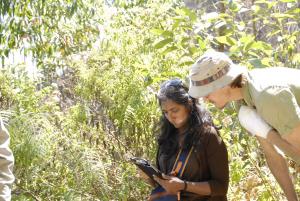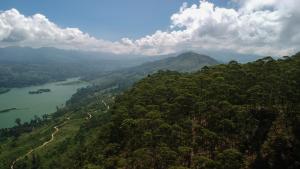Local Heroes – WWCT Sri Lanka
This weeks Local Hero is Anjali Watson from the Wilderness and Wildlife Conservation Trust (WWCT), Sri Lanka. The Lanka Environment Fund (LEF) has supported WWCT’s ‘Identification and Establishment of Forest Corridors/Conservation Zones in Sri Lanka’s Central Highlands’ project.
Please tell us about your project.
Previous research conducted by WWCT shows that leopard -Sri Lanka’s apex predator- habitat suitability is improved by increasing the level of protection of the landscape and ensuring sizeable tracts of forest with a dense network of connected patches to buffer core habitat. Sri Lanka’s current protected area network is unbalanced, with the majority found in the lowland dry zone and very little in either the lowland wet-zone or Central Highlands, where biodiversity and endemism is high and where ecosystem resources are heavily focused. Furthermore, this network is lacking in adequate connections with areas of unprotected mixed wilderness and plantation lands often falling between protected areas. This project seeks to add much needed conservation zones / forest corridors to this landscape. By building on our previous leopard research we intend to identify key wildlife, especially leopard use areas in the southern Highlands that could function as vital corridors and additional refuges between the few protected areas that exist here.
Why do you do what you do?
Focusing our work on the leopard, which is this islands only wide ranging large carnivore/big cat, terrestrial apex predator and ideal umbrella species for conservation, will we hope enable a quicker more coherent plan for conservation. We do not have the land area nor the luxury of time to pick and choose how we conserve our vital biodiversity and remaining wilderness, and so we must select a path that best allows for overarching conservation. The leopard I believe is an answer to this. Needless to say its sheer magnificence and the vital role it has on this island, keeps me doing what I do!
How has LEF helped you?
LEF has helped us to quickly attempt to replicate a successful previous project that identified a key connecting ridge area for wildlife and which proved to also hold a resident leopard population. We have identified two other similar ridgelines in the vicinity of the previous ridge in the southern Central Highlands and the LEF grant is enabling us to investigate if these two ridges also act as key connectors and refuges for leopard and other wildlife. The LEF funds allowed us to stay on and continue our work in this tea plantation and mixed forest landscape and move quickly to focusing on these other ridges, thereby increasing, we hope, the impact of our earlier work.
What is the biggest challenge you face?
Continuation of funding is the need of the hour as due to the Covid-19 pandemic our field work was greatly impacted and we have not been able to get through our planned course of action. This means that the project timeline and outcomes will need to be extended and to sustain the work of our team we will need to have continued support. With the tea industry in Sri Lank in dire straits it is now not as easy to get the parent companies to agree to the partnerships we envisaged as they face multiple labour and capital funding issues themselves and priorities have shifted. We need to ensure that we keep at it…
Anything to add?
One simply needs to spend time in the wilderness to understand how deeply it impacts us and how essential it is to our being. If these spaces and magnificent species like the leopard are to continue to persist and if we are to give our children and their children a world like I have been lucky enough to experience, then we must act now – we must be the solution.



